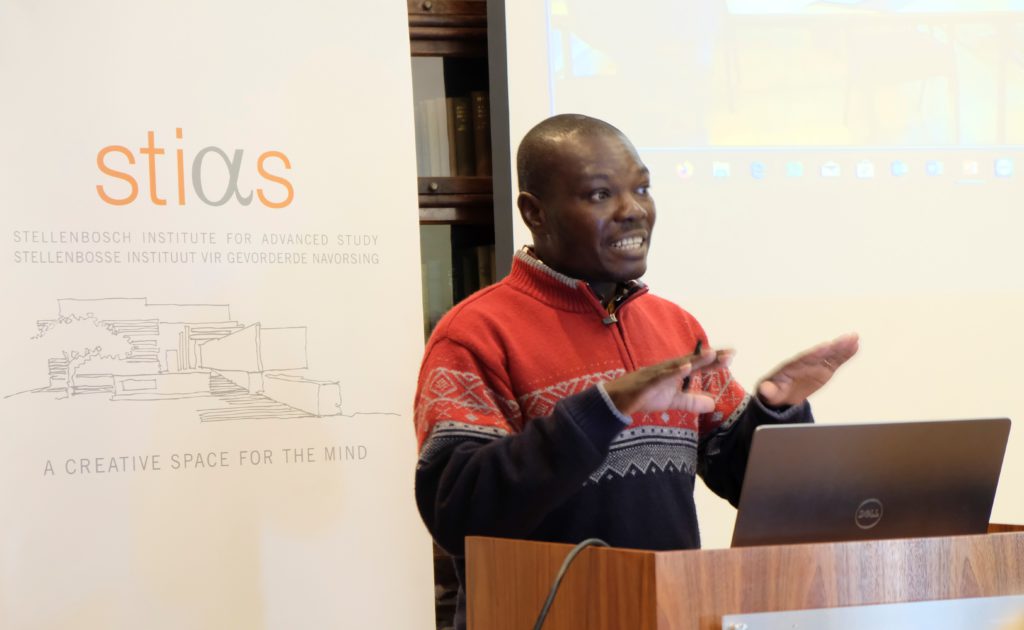Sensors are mechanisms or devices that can convert chemical, physical and biological responses into electronic signals. Sensor technology has many practical uses across science and technology. It is currently being used for a wide range of applications including detecting diseases at the level of nanoparticles, tracing environmental pollution, measuring water salinity, as well as for acoustics, cell-phone and even biosensors. But we need to enhance the sensitivity of sensors and this is the quest of Iso Lomso fellow Philippe Djorwé of the Department of Physics at the University of Ngaoundéré in Cameroon. Djorwé is part of the sixth cohort of Iso Lomso fellows at STIAS and was presenting his first seminar.

His work is in the broad field of opto-electromechanics which has developed over the past 20 years and brings together optics, electronics and mechanics.
“Electromechanics involves the act or control of mechanical motion by electrical signals,” explained Djorwé, “while optomechanics is the activation or control of mechanical motion by an optical field – usually a laser.”
Bringing the three together has had a profound effect on reinforcing some of the fundamental theories of quantum mechanics. Djorwé explained that there was long debate in the history of quantum mechanics. “In the 1700s Newton saw light as particles, about 100 years later Thomas Young described light as behaving like waves, and another 100 years later Einstein said light can have both behaviours. This became the theory of light with light as a particle and a wave depending on the type of experimental result to be obtained.”
“Particles or photons are a package of energy. Illuminating with a laser is basically throwing photons at an object,” explained Djorwé. “While phonons are the energy of vibration – anything that vibrates is able to generate phonons. Phonon and photon interactions give us optomechanics, a light/matter interaction.”
A focus on the ‘exceptional’
Along with colleagues at the University of Lille in France where he was a postdoc fellow, Djorwé has found that an approach based on ‘exceptional points’ may lead to more sensitive sensors compared to conventional approaches. Most complex systems operate on the basis of gains and loss. Exceptional points (EPs) are singularities in systems with balanced gain and loss, leading to more interesting phenomena.
“Conventionally, a nanoparticle enters the mode volume of a cavity as a perturbation, leading to eigen frequency splitting that is proportional to the perturbation strength,” said Djorwé. “The proposed new approach is based on EPs, which are non-Hermitian singularities – or points at which the eigen value switches from real to complex values. Owing to the topology characteristic at the EPs, the frequency splitting on the small perturbation leads to a giant enhancement compared with conventional sensors with the same perturbation.”
In this optomechanical system the gain (loss) is engineered, the EP shows up in the system when the gain balances losses, and any perturbation leads to a frequency splitting that scales as the square-root of the perturbation strength which greatly enhances the detection.
They have shown that it is possible to engineer electromechanical-based exceptional points and the work will now focus on electromechanical systems operating both at EPs and at higher-order EPs (HOEPs) to see if this can further increase sensitivity. Both theoretical and experimental investigations will be carried out, and some quantum-related phenomena such as heat transport and quantum entanglement will be explored.
“We know already that EP-based sensors are superior to conventional sensors – in terms of resonance and the production of more resolved peaks. EP makes detection easier and more sensitive. It is more efficient even when the size of the particle is small. Higher-order EP is likely to result in even higher resolution. If you can engineer it, it will be good for sensors.”
Djorwé pointed out that EPs more generally exhibit other interesting properties. “We aim to further figure out the properties of EPs in the opto-electromechanical array. The quantum concepts such as multipartite entanglement, photon/phonon non-reciprocal/topological transport, and quantum synchronisation based on EPs are some interesting outputs expected from this project.”
Bringing it home
And although direct practical applications may still be some years away, a huge motivation for Djorwé is to transfer the knowledge he has gained from his international studies in France and at the Catalan Institute of Nanoscience and Nanotechnology in Spain back to his country by establishing a research group and putting his research back into his home institution, the University of Ngaoundéré in Cameroon.
“Our motivation is to transfer our knowledge in order to extend this research field to colleagues with a quantum electronic background,” he said. “This project constitutes not only a step towards an establishment of strong collaborative network with African researchers who have a good understanding of electronic circuits, but it will lead us also to deeply explore quantum electronics.”
“We are hoping the research can help communities in practical ways but also hoping to establish electronics expertise and facilities in Cameroon and to generate research on EP in electronic circuits, looking for new ways to engineer EPs and HOEPs.”
Michelle Galloway: Part-time media officer at STIAS
Photograph: Noloyiso Mtembu
